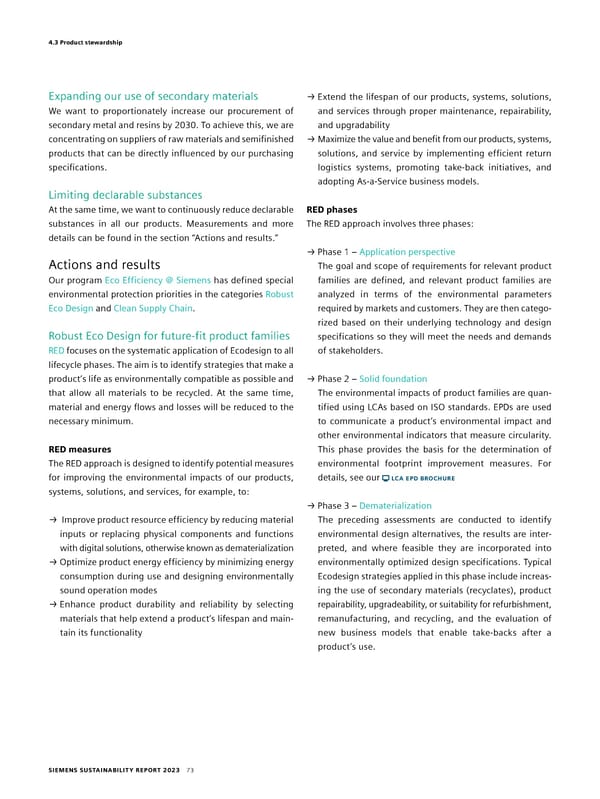4.3 Product stewardship Expanding our use of secondary materials → Extend the lifespan of our products, systems, solutions, We want to proportionately increase our procurement of and services through proper maintenance, repairability, secondary metal and resins by 2030. To achieve this, we are and upgradability concentrating on suppliers of raw materials and semifinished → Maximize the value and benefit from our products, systems, products that can be directly influenced by our purchasing solutions, and service by implementing efficient return specifications. logistics systems, promoting take-back initiatives, and adopting As-a-Service business models. Limiting declarable substances At the same time, we want to continuously reduce declarable RED phases substances in all our products. Measurements and more The RED approach involves three phases: details can be found in the section “Actions and results.” → Phase 1 – Application perspective Actions and results The goal and scope of requirements for relevant product Our program Eco Efficiency @ Siemens has defined special families are defined, and relevant product families are environmental protection priorities in the categories Robust analyzed in terms of the environmental parameters Eco Design and Clean Supply Chain. required by markets and customers. They are then catego- rized based on their underlying technology and design Robust Eco Design for future-fit product families specifications so they will meet the needs and demands RED focuses on the systematic application of Eco design to all of stakeholders. lifecycle phases. The aim is to identify strategies that make a product’s life as environmentally compatible as possible and → Phase 2 – Solid foundation that allow all materials to be recycled. At the same time, The environmental impacts of product families are quan- material and energy flows and losses will be reduced to the tified using LCAs based on ISO standards. EPDs are used necessary minimum. to communicate a product’s environmental impact and other environmental indicators that measure circularity. RED measures This phase provides the basis for the determination of The RED approach is designed to identify potential measures environmental footprint improvement measures. For for improving the environmental impacts of our products, details, see our LCA EPD BROCHURE systems, solutions, and services, for example, to: → Phase 3 – Dematerialization → Improve product resource efficiency by reducing material The preceding assessments are conducted to identify inputs or replacing physical components and functions - environmental design alternatives, the results are inter with digital solutions, otherwise known as dematerialization preted, and where feasible they are incorporated into → Optimize product energy efficiency by minimizing energy environmentally optimized design specifications. Typical consumption during use and designing environmentally Ecodesign strategies applied in this phase include increas- sound operation modes ing the use of secondary materials (recyclates), product → Enhance product durability and reliability by selecting repairability, upgradeability, or suitability for refurbishment, materials that help extend a product’s lifespan and main- remanufacturing, and recycling, and the evaluation of tain its functionality new business models that enable take-backs after a product’s use. SIEMENS SUSTAINABILITY REPORT 2023 73
 Sustainability Report Page 72 Page 74
Sustainability Report Page 72 Page 74